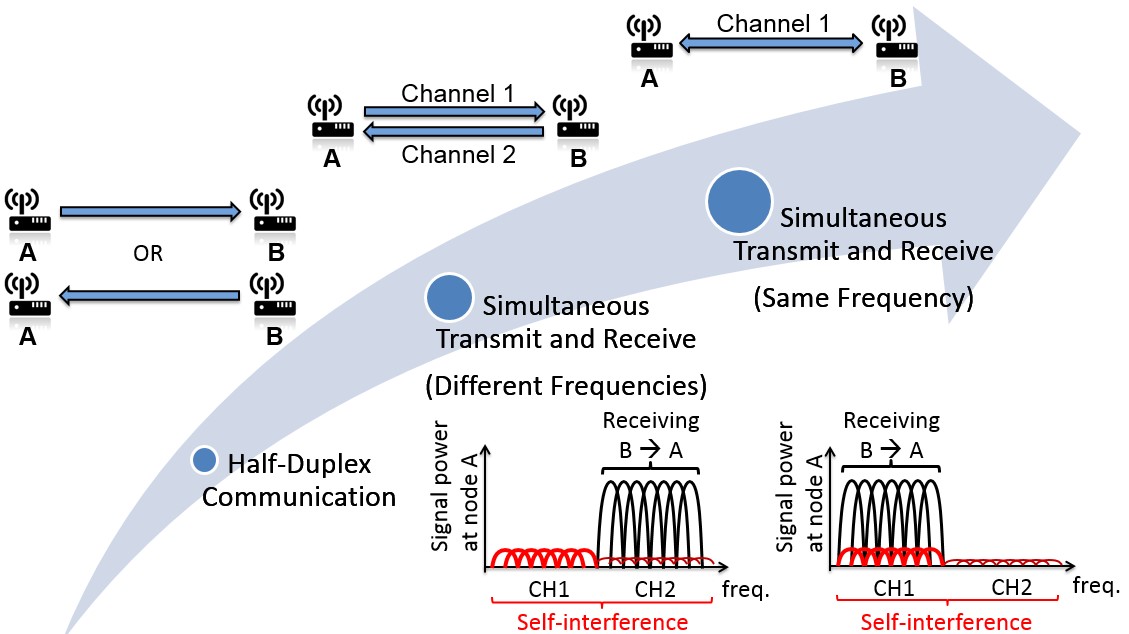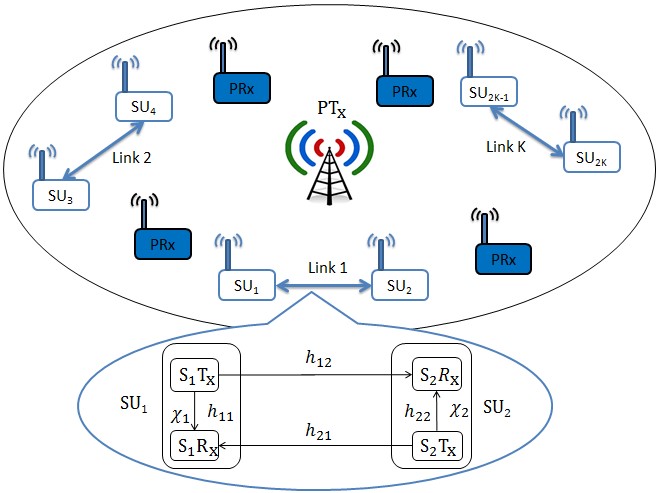|
 |
Figure 1: Full-duplex vs. half-duplex communications.
|
Motivation - Traditional handheld radios are half-duplex (HD), with
one transceiver used
for alternate transmission and reception. More advanced radios can use two or more
transceivers, allowing the radio to perform simultaneous transmission and reception over
different transmit and receive channels (henceforth called STAR-D capability). In theory, it is possible to implement STAR-D with a single transceiver by exploiting orthogonal frequency division multiple access (OFDMA) technology. However, this is not quite straightforward when the transmission and reception channels are adjacent, with no or little guard-band in between to shield the receiver from the transmitted signal's side lobes and "spectral leakage" (caused by filter imperfections). Simultaneous transmission and reception over the same channel (STAR-S) is a further advancement over STAR-D. Its ultimate goal is to achieve full-duplex (FD) communications using a single transceiver (see Figure 1).
Until recently, STAR-S was deemed impossible. Essentially, the problem is that the transmitted power from a given device
is typically much higher than the received power of another signal that the same device is trying to capture. While the device is
receiving a signal, its own transmitted signal is considered as self-interference. The infeasibility of STAR-S
communications has recently been challenged by several research groups, which have successfully demonstrated the possibility
of FD communications using self-interference suppression (SIS) techniques. The main idea in these works is to
sufficiently suppress self-interference through a combination of techniques (e.g., RF analog cancellation, digital baseband
interference cancellation, circulators, phase shifters, etc.) to a level that enables FD communications. Specifically, it has
been shown that a node's own transmission can be suppressed by up to 110 dB (noise floor), depending on the underlying SIS
schemes. Such a level of SIS has significant ramifications on network protocols, which are often designed under the
assumption of HD radios.
 |
Figure 2: System model for a secondary network, where SUs opportunistically access the spectrum of a PU network. Each SU i consists of a transceiver with a given SIS capability factor χi . hij is the channel gain from transmitter i to receiver j. PRx is a PU receiver, PTx is a PU transmitter.
|
Research Agenda - In this project, we investigate the application of SIS in dynamic
spectrum access (DSA) systems. Specifically, we consider an opportunistic DSA system in which a network of secondary
users (SUs) coexists geographically with one or more primary user (PU) networks (see Figure 2). In a typical DSA
setup, a transmitting SU must periodically interrupt its transmission and sense the underlying channel for any PU activity.
This process, known as Listen-Before-Talk (LBT), results in unnecessary degradation in the throughput of the secondary network,
not to mention its undesirable effect on real-time communications. An SU device can exploit SIS to remedy this situation by
performing simultaneous transmission and sensing (TS) on the same channel. Alternatively, the SU can exploit
SIS to enable bidirectional simultaneous transmission-reception (TR) over the same channel while still implementing a
LBT strategy. In general, a combination of the two models (TS and TR) is possible, as illustrated in Figure 3(b).
In this project, we investigate the optimal policy for the SU link, taking into consideration the tradeoff between
spectrum efficiency (enhancing the throughput by operating in the TR mode) and spectrum awareness (improving the detection
capability by operating in the TS mode).
When operating in the TS mode, the SU may conduct the sensing operation over multiple (consecutive) short periods instead of
one long sensing period (see Figure 4). Formally, while transmitting data for a period of T seconds, the SU may sense
the spectrum for m consecutive sensing periods Tsi, i=1,2,...,m. The motivation behind this approach is to account
for the tradeoff between sensing efficiency and the timeliness in detecting PU activity. Basically, by increasing the duration
of a sensing period, the SU can achieve better sensing efficiency (reduce the false-alarm and miss-detection probabilities).
On the other hand, such an increase implies delaying the time to make a decision regarding the presence/absence of PU
activity. Note that during any sensing period, the SU samples the energy of the channel
several times, computes the average of these measurements, and decides
at the end of that sensing period whether the PU is active or idle.
Furthermore, because the sensing efficiency in the TS mode depends on how much SIS is possible,
in some cases it may be preferable
for the SU to operate in a sensing-only (SO) mode (as in the LBT strategy) so as to ensure acceptable sensing accuracy.
Considering the availability of multiple channels, the SU may also decide to perform channel switching (CS) if the PU is highly likely to return to the currently used channel. An important aspect of our research effort deals with determining how to optimally switch between different possible modes, considering a highly dynamic wireless environment and the possibility of colliding with PUs. Specific tasks include the following.
 |
Figure 3: Listen-Before-Talk scheme vs. SIS-enabled TS and TR modes (shown combined). 'T' stands for transmitting, 'R' stands for receiving, and 'S' stands for sensing.
|
 |
Figure 4: Transmission-sensing mode.
|
- Optimal Transmission/Sensing/Reception Strategy
In this task, we aim at finding the optimal strategy that maximizes the SU's "utility" (e.g., link throughput) subject to a
constraint on the PU outage probability. One possible approach to achieve this goal is to formulate the problem as a partially
observable Markov decision process (POMDP) and analyze the four actions (TR, TS, SO, CS) by determining
the myopic and long-term rewards. The optimal strategy is found to be threshold-based, with thresholds that depend on the SU's belief about the PU state. Based on this belief, the SU will take an optimal action and then update his belief according to the outcome of that action. This outcome may be an ACK/NACK in case of transmission, free/busy in case of sensing, and decodable/undecodable in case of reception. The SU may also get a combination of these outcomes.
- Sensing Accuracy under the TS Mode
The accuracy of any spectrum sensing technique is often expressed in terms of false-alarm and detection probabilities. As discussed before, in the TS mode this accuracy is directly impacted by the degree of SIS. In practice, it may not be possible to achieve 100% SIS, so when deriving the false-alarm and detection probabilities, one must account for the residual self-interference. This applies to both energy- as well as waveform-based sensing. Note that while energy-based sensing is widely used due to its simplicity, it cannot differentiate between various types of users. In contrast, waveform-based sensing relies on certain signatures of the PU signal for detection (e.g., known preambles, pilot symbols, etc.). In this task, we focus on evaluating the performance of both sensing techniques when used with the TS mode.
- Resource Allocation for Full-duplex Modes
- Sensing and Transmission Durations
One important direction that is being pursued is optimizing the number of sensing periods within one transmission duration
in the TS mode so as to minimize the PU outage probability (see Figure 4). We are also studying the sensing
accuracy/throughput tradeoff for SUs under both TS and TR modes. Specifically, for both modes we seek to determine the
optimal sensing and transmission durations that maximize the SU's throughput subject to constraints on the PU outage
probability. The PU/SU collision probability and the SU throughput are studied for both modes.
- Transmission Power Control
We also investigate the power control problem for SUs, operating in the TR mode. In here, we consider a spectrum
underlay model with K SU links. The objective is to find the optimal SU transmission powers that maximize the
sum throughput of the K secondary links, operating in a FD fashion, under a PU outage probability constraint. There exists a
tradeoff between limiting the interference (either self-interference or that of the PU) and efficiently utilizing the
spectrum. On the one hand, the SU can increase the throughput of its link by transmitting and receiving data simultaneously
over the same frequency channel. This can be done by operating in the TR mode. On the other hand, the SU can decrease the
self-interference at its own node (especially under limited SIS capabilities) and control the interference at the
PU receiver by either decreasing the transmission power or working in a HD fashion (i.e., operating in the
transmission-only mode). Therefore, operating in FD fashion is not always efficient for SUs with low SIS capabilities
due to high self-interference that will reduce the achievable SU throughput. We are investigating the optimal switching
policy that determines the criteria for operating in either FD or HD fashion. These criteria depend mainly on the SIS
capability of the communicating nodes, along with other parameters such as channel gains.
- Transmission Coordination Protocol
We are also designing appropriate protocols that would allow SUs to switch between various modes. We are also addressing
how two SUs negotiate over the control plane so as to achieve consistent operation and select the optimal action/mode given
that two SUs may have different traffic volumes.
Related Publications
- Wessam Afifi and Marwan Krunz, "Optimal transmission-sensing-reception strategies for full-duplex dynamic spectrum access", University of Arizona, Department of ECE, TR-UA-ECE-2013-4, Nov. 2013.
- Wessam Afifi and Marwan Krunz, "Exploiting self-interference suppression for improved spectrum awareness/efficiency in cognitive radio systems", Proc. of the IEEE INFOCOM 2013 Conference, Turin, Italy, April 2013.
|